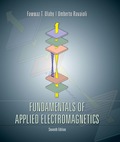
Fundamentals of Applied Electromagnetics (7th Edition)
7th Edition
ISBN: 9780133356984
Author: ULABY
Publisher: PEARSON
expand_more
expand_more
format_list_bulleted
Concept explainers
Textbook Question
Chapter 1, Problem 14P
A certain electromagnetic wave traveling in seawater was observed to have an amplitude of 98.02 (V/m) at a depth of 10 m, and an amplitude of 81.87 (V/m) at a depth of 100 m. What is the attenuation constant of seawater?
Expert Solution & Answer
Want to see the full answer?
Check out a sample textbook solution
Students have asked these similar questions
Please solve this questions step by step detailed and handwritten, do not use chat gpt or other ai tools thanks!
Please solve this question step by step with explanation and handwritten solution please do not use chat gpt or other ai tools thanks
Please solve this question fully step by step handwritten and do not use chat gpt or any ai tools thanks
Chapter 1 Solutions
Fundamentals of Applied Electromagnetics (7th Edition)
Ch. 1.3 - Prob. 1CQCh. 1.3 - What is Coulombs law? State its properties.Ch. 1.3 - What are the two important properties of electric...Ch. 1.3 - What do the electrical permittivity and magnetic...Ch. 1.3 - What are the three branches and associated...Ch. 1.4 - How can you tell if a wave is traveling in the...Ch. 1.4 - Prob. 7CQCh. 1.4 - Why does a negative value of 0 signify a phase...Ch. 1.4 - Consider the red wave shown in Fig. E1.1. What is...Ch. 1.4 - The wave shown in red in Fig. E1.2 is given by...
Ch. 1.4 - The electric field of a traveling electromagnetic...Ch. 1.4 - Prob. 4ECh. 1.4 - The red wave shown in Fig. E1.5 is given by...Ch. 1.4 - An electromagnetic wave is propagating in the z...Ch. 1.5 - What are the three fundamental properties of EM...Ch. 1.5 - What is the range of frequencies covered by the...Ch. 1.5 - Prob. 11CQCh. 1.6 - Express the following complex functions in polar...Ch. 1.6 - Show that 2j=(1+j). (See EM.)Ch. 1.7 - Prob. 12CQCh. 1.7 - How is the phasor technique used when the forcing...Ch. 1.7 - A series RL circuit is connected to a voltage...Ch. 1.7 - A phasor voltage is given by V=j5V. Find (t).Ch. 1 - A 2 kHz sound wave traveling in the x direction in...Ch. 1 - For the pressure wave described in Example 1-1,...Ch. 1 - A harmonic wave traveling along a string is...Ch. 1 - A wave traveling along a string is given by...Ch. 1 - Two waves, y1(t) and y2(t), have identical...Ch. 1 - The height of an ocean wave is described by the...Ch. 1 - A wave traveling along a string in the +x...Ch. 1 - Two waves on a string are given by the following...Ch. 1 - Give expressions for y(x, t) for a sinusoidal wave...Ch. 1 - An oscillator that generates a sinusoidal wave on...Ch. 1 - Prob. 11PCh. 1 - Given two waves characterized by...Ch. 1 - The voltage of an electromagnetic wave traveling...Ch. 1 - A certain electromagnetic wave traveling in...Ch. 1 - Prob. 15PCh. 1 - Prob. 16PCh. 1 - Complex numbers z1 and z2 are given z1=3j2z2=4+j3...Ch. 1 - Complex numbers z1 and z2 are given by...Ch. 1 - If z=2+j4, determine the following quantities in...Ch. 1 - Find complex numbers t=z1+z2 and s=z1z2, both in...Ch. 1 - Complex numbers z1 and z2 are given by...Ch. 1 - If z=3j5, find the value of ln(z).Ch. 1 - If z = 3 j4. find the value of ez.Ch. 1 - Prob. 24PCh. 1 - A voltage source given by s(t)=25cos(2103t30)(V)...Ch. 1 - Find the phasors of the following time functions:...Ch. 1 - Find the instantaneous time sinusoidal functions...Ch. 1 - A series RLC circuit is connected to a generator...Ch. 1 - The voltage source of the circuit shown in Fig....
Knowledge Booster
Learn more about
Need a deep-dive on the concept behind this application? Look no further. Learn more about this topic, electrical-engineering and related others by exploring similar questions and additional content below.Similar questions
- Please solve this question step by step hand written solution and do not use chat gpt or any ai tools thanks!arrow_forwardPlease Solve this question step by step handwritten solution and do not use chat gpt or any ai tools thanks!arrow_forwardPlease solve this question step by step handrwitten solution and do not use chat gpt or any ai tools thanks.arrow_forward
arrow_back_ios
SEE MORE QUESTIONS
arrow_forward_ios
Recommended textbooks for you
 Introductory Circuit Analysis (13th Edition)Electrical EngineeringISBN:9780133923605Author:Robert L. BoylestadPublisher:PEARSON
Introductory Circuit Analysis (13th Edition)Electrical EngineeringISBN:9780133923605Author:Robert L. BoylestadPublisher:PEARSON Delmar's Standard Textbook Of ElectricityElectrical EngineeringISBN:9781337900348Author:Stephen L. HermanPublisher:Cengage Learning
Delmar's Standard Textbook Of ElectricityElectrical EngineeringISBN:9781337900348Author:Stephen L. HermanPublisher:Cengage Learning Programmable Logic ControllersElectrical EngineeringISBN:9780073373843Author:Frank D. PetruzellaPublisher:McGraw-Hill Education
Programmable Logic ControllersElectrical EngineeringISBN:9780073373843Author:Frank D. PetruzellaPublisher:McGraw-Hill Education Fundamentals of Electric CircuitsElectrical EngineeringISBN:9780078028229Author:Charles K Alexander, Matthew SadikuPublisher:McGraw-Hill Education
Fundamentals of Electric CircuitsElectrical EngineeringISBN:9780078028229Author:Charles K Alexander, Matthew SadikuPublisher:McGraw-Hill Education Electric Circuits. (11th Edition)Electrical EngineeringISBN:9780134746968Author:James W. Nilsson, Susan RiedelPublisher:PEARSON
Electric Circuits. (11th Edition)Electrical EngineeringISBN:9780134746968Author:James W. Nilsson, Susan RiedelPublisher:PEARSON Engineering ElectromagneticsElectrical EngineeringISBN:9780078028151Author:Hayt, William H. (william Hart), Jr, BUCK, John A.Publisher:Mcgraw-hill Education,
Engineering ElectromagneticsElectrical EngineeringISBN:9780078028151Author:Hayt, William H. (william Hart), Jr, BUCK, John A.Publisher:Mcgraw-hill Education,

Introductory Circuit Analysis (13th Edition)
Electrical Engineering
ISBN:9780133923605
Author:Robert L. Boylestad
Publisher:PEARSON

Delmar's Standard Textbook Of Electricity
Electrical Engineering
ISBN:9781337900348
Author:Stephen L. Herman
Publisher:Cengage Learning

Programmable Logic Controllers
Electrical Engineering
ISBN:9780073373843
Author:Frank D. Petruzella
Publisher:McGraw-Hill Education

Fundamentals of Electric Circuits
Electrical Engineering
ISBN:9780078028229
Author:Charles K Alexander, Matthew Sadiku
Publisher:McGraw-Hill Education

Electric Circuits. (11th Edition)
Electrical Engineering
ISBN:9780134746968
Author:James W. Nilsson, Susan Riedel
Publisher:PEARSON

Engineering Electromagnetics
Electrical Engineering
ISBN:9780078028151
Author:Hayt, William H. (william Hart), Jr, BUCK, John A.
Publisher:Mcgraw-hill Education,
What Is a Plane Wave? — Lesson 2; Author: EMViso;https://www.youtube.com/watch?v=ES2WFevGM0g;License: Standard Youtube License